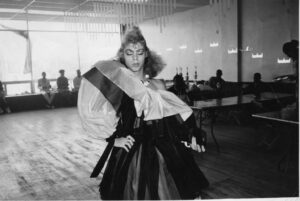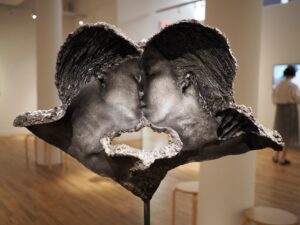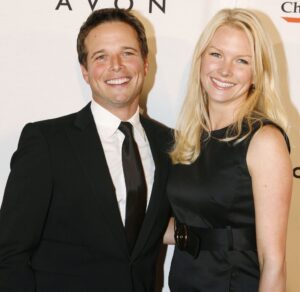Guerrilla Girls: Fighting Discrimination, One Poster at a Time

As revolutionaries often do, the feminist collective known as Guerrilla Girls began its battle against sexism in the arts with a list of names. Their first posters appeared overnight in May 1985, wheat-pasted onto walls and kiosks throughout SoHo, New York’s primary gallery district at the time. Along the upper border of each print ran a question, emphatic in all caps: “WHAT DO THESE ARTISTS HAVE IN COMMON?”
Emblazoned black on white in bold, sans-serif font, the subsequent dossier enumerated interdisciplinary artists known for their vanguardism, all successful, all male: Jean-Michel Basquiat, Keith Haring, Bruce Nauman, Claes Oldenburg, the list went on. At each sheet’s lower edge, an answer to the headline question was given: All allowed their work to be represented by galleries who showed 10 percent or fewer women artists. The public service announcement was signed, “Guerrilla Girls, Conscience of the Art World.”

Guerrilla Girls, What Do These Artists Have in Common? New York City, 1985
Copyright © Guerrilla Girls, courtesy guerrillagirls.com. Photo: Lori Grinker.
Since then, the Guerrilla Girls have lambasted cultural producers, galleries, institutions, and collectors alike in splashy, provocative posters broadcasting uncomfortable realities about gender and racial inequality. Appropriating marketing aesthetics and radical distribution tactics, they follow a statistics-driven approach; as outlined in the press release that announced their formation, “Simple facts will be spelled out; obvious conclusions can be drawn.”
This year marks the Guerrilla Girls’ 40th anniversary, celebrated by retrospective exhibitions at the National Museum for Women in the Arts (NMWA) in Washington, D.C., the Getty Research Institute in Los Angeles, and the National Gallery of Bulgaria in Sofia. Reexamining their incendiary trajectory in the arts and on the streets, one thing is clear: Their uncompromising activism hits as hard today as it did when they began their practice four decades ago.

Guerrilla Girls, The Advantages of Being A Woman Artist, 1988
Copyright © Guerrilla Girls, courtesy guerrillagirls.com.
All accounts place the Guerrilla Girls’ origins in the summer of 1984, with the opening of the exhibition “An International Survey of Recent Painting and Sculpture,” curated by Kynaston McShine at the Museum of Modern Art (MoMA) in New York. Of the 169 participants, only 13 were women and even fewer were people of color. To protest discriminatory curatorial practices, several feminist activist groups—including the Women’s Caucus for Art, the Heresies Collective, the Feminist Art Institute, and the Women’s Interart Center—organized the Women Artists Visibility Event (WAVE) in front of the museum. However, the demonstration did not have the desired impact. Visitors were all but oblivious to the picket line and walked around it to enter MoMA’s lobby.
Realizing that the methodologies of an earlier generation no longer resonated with the general public, several women began to meet to discuss other ways of responding to the sexism and racism blatant in the cultural sphere. “The art world isn’t avant-garde; it’s derriere,” reflected pseudonymous Guerrilla Girls “Frida Kahlo” and “Käthe Kollwitz” in a 2008 oral history interview with the Smithsonian’s Archives of American Art.
Despite greater equality in the marketplace writ large, at the time of the collective’s founding, male artists still out-earned women two to one (the subject of another Guerrilla Girls sign from 1985). During their first convening in April 1985 at 513 Broadway in SoHo, “Kahlo” and “Kollwitz” suggested the framework of their first poster, taking their male peers to task for complicity with a system that privileged men above all others. Similar designs keyed to exclusionary galleries, critics, and museums soon followed.

Guerrilla Girls, Do women Have to Be Naked to Get Into the Met. Museum? Update, from the series “Guerrilla Girls Talk Back: Portfolio 2,” 2005
Copyright © Guerrilla Girls, courtesy guerrillagirls.com
The Guerrilla Girls’ direct, confrontational stratagems were palpably alluring, winning them an audience even while their accusations antagonized the upper echelons of the arts ecosystem. Within five years of their debut, they had been covered by the Village Voice, New York magazine, New York Times, and Artforum. By 1992 they’d also sneaked into the pages of Vogue.
To protect their personal lives and careers from backlash in the face of attention both good and ill, the art world vigilantes adopted noms de guerre and, during public appearances, donned gorilla masks (a mascot born from a typographic error). These pseudonyms now number in the sixties—counting all the members from 1985 to today—and represent an informal revisionist canon of deceased women artists and writers.
Speaking by phone about their aliases, “Kollwitz” said, “They honor these women of the past, many of whom had been forgotten when we started so many decades ago.” After our conversation, she sent me a roster that featured Zora Neale Hurston, Shigeko Kubota, Ana Mendieta, Liubov Popova, Alma Thomas, and Chiyo Uno.
Across the Guerrilla Girls’ career, the focus of their activism has gradually expanded, first encompassing the visual arts and, later, a world beyond. Through 1989 their attention remained trained on the New York art scene as they attacked the misogyny they found there. It was during this period that they conducted their iconic audit of the Metropolitan Museum, which resulted in the bus banner Do Women Have To Be Naked To Get Into the Met. Musuem? (1989).

Guerrilla Girls, Guerrilla Girls’ Pop Quiz, from the series “Guerrilla Girls Talk Back: The First Five Years, 1985-1990,” 1990
Copyright © Guerrilla Girls, courtesy guerrillagirls.com. Photo: Lee Stalsworth.
Beside a recumbent female figure lifted from Jean Auguste Dominique Ingres’s Grande Odalisque (1814)—in their revision, wearing a snarling gorilla head—black and hot pink text blocks reveal that women represented only 5 percent of the artists in the museum’s Modern wing yet 85 percent of the nudes. This focus on gender equity went hand in hand with an intersectional alliance with racial minorities. For example, in a 1987 poster, they asked, “What’s fashionable, prestigious, and tax-deductible?” The answer: “Discriminating against women and non-white artists.”
In the 1990s the group’s self-appointed jurisdiction began to grow, its members speaking out on U.S. politics and urgent issues such as abortion, LGBTQ+ rights, the environment, and censorship. Guerrilla Girls’ Pop Quiz (1990) questioned the merit of government-instituted markers of social justice, challenging national awareness months as glorified lip service. The print asked, “If February is Black History Month and March is Women’s History Month, what happens the rest of the year?” The pithy riposte: “Discrimination.” During the pro-choice march on Washington in 1992, members of the group carried another wry sign, Guerrilla Girls Demand a Return to Traditional Values on Abortion (1992), which highlighted that early pregnancy termination was legal up to the 1850s.

Guerrilla Girls, Guerrilla Girls Demand a Return to Traditional Values on Abortion, Pro-Choice March, Washington, D.C., 1992
Copyright © Guerrilla Girls, courtesy guerrillagirls.com.
In the 2000s, with changes in design and print processes brought on by the digital revolution, the Guerrilla Girls traded in the monochrome and grayscale of earlier decades for an explosive world of color, while also tapping into an increasingly international network of platforms and co-conspirators. Reflecting on this most recent era in their practice, “Kollwitz” added with zeal, “Now we have the power to put our work up all over the world.” One such international arena was the 2005 Venice Biennale, the first to be organized by women curators, María de Corral and Rosa Martínez. When invited to participate, the Guerrilla Girls created an installation of six 17-foot banners that underscored the absence of women artists in the biennale’s history and the city’s exhibition spaces.
For a group famed for institutional critique, the museological reification of the Guerrilla Girls over the past 20 years poses its own conceptual challenge, as their works have been collected and exhibited by international art museums including MoMA, the Centre Pompidou in Paris, the Museo Reina Sofía in Madrid, and the Tate Modern in London. Rather than fighting these endorsements, the Guerrilla Girls have leaned into them as opportunities to produce new, research-based artworks and engage directly with the audience that is poised to care most about equity within and beyond the arts.

Guerrilla Girls, Women of Bulgaria Put on A Crash Diet, The Bulgarian Fund For Women March, Sofia, Bulgaria, 2025
Copyright © Guerrilla Girls, courtesy guerrillagirls.com. Photo: Rosina Pencheva.
For example, as part of their retrospective at the National Gallery of Bulgaria this year (running through August 6), they produced a poster responding to the paucity of women in the national Council of Ministers (only 1 in 20). Beside an image of a banitsa—a traditional Bulgarian pastry—from which a meager portion has been cut, Cyrillic lettering announces, “Women of Bulgaria put on a crash diet! Don’t they deserve more than a thin slice of government?” Young women and representatives from the Guerrilla Girls carried the poster in banner form as part of the procession for women’s rights that took place in Sofia on March 11.
Their current survey at NMWA, Guerrilla Girls: Making Trouble, on through September 28, is particularly resonant in light of the parallel history of the institution, also founded in the 1980s to champion female artists. On a recent phone call, exhibition curator Hannah Shambroom remarked, “The formation of the Guerrilla Girls and the way that NMWA was developed really came out of a similar recognition of both exclusion and also undervaluing of the art of women.”
In tribute to their shared mission, the museum honored the collective at its annual gala, which was scheduled to coincide with the show’s opening. Drawn entirely from NMWA’s collection, the retrospective presents work from 1985 to 2024, including a wall-scale reproduction of Guerrilla Girls ManifestA: For Art Museums Everywhere (2024), which recalls street interventions ranging in scale from bumper stickers to billboards.

Installation view of “Guerrilla Girls: Making Trouble,” National Museum of Women in the Arts, Washington, D.C., April 12 to September 28, 2025
Copyright © Guerrilla Girls, courtesy guerrillagirls.com. Photo: Kevin Allen.
“I wanted to highlight that the group was at the forefront of artist advocacy work,” Shambroom said, reflecting on the Guerrilla Girls’ legacy and her curatorial process. “One thing I was really struck by as I was looking through our collection and their more recent works was how relevant many of the issues they were addressing continue to feel—still part of the news, still part of the public consciousness.”
At a time when reproductive rights and freedom of speech are challenged anew, the Guerrilla Girls and their perennially timely confrontation of authority demonstrate that much can be achieved by a few determined individuals. They remain insistent that more remains to be done. Unsurprisingly, the Guerrilla Girls know best how to describe their ongoing mission. In a 2016 appearance on The Late Show With Stephen Colbert, “Kahlo” said, “We say art should look like the rest of our culture. Unless all the voices of our culture are in the history of art, it’s not really a history of art, it’s a history of power.
“Guerrilla Girls: Making Trouble” is on view at the National Museum of Women in the Arts, Washington, D.C. through September 28, 2025; “Guerrilla Girls: The Art of Behaving Badly” is on view at the National Gallery Sofia, Bulgaria, through August 6, 2025; “How to Be a Guerrilla Girl” will be on view at the Getty Research Center, Los Angeles, from November 18, 2025 to April 12, 2026








